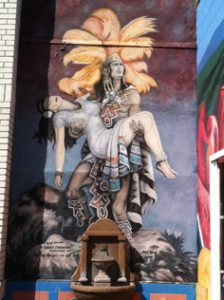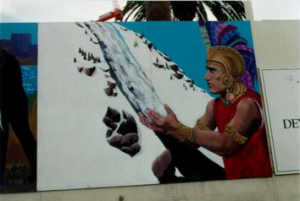Driving along Vermont Street in Los Angeles, an amazing wall mural peaks out of a bakeries wall. It’s vibrant, deep colors and content make us feel as if we were in another world. The roots of the Aztecs in this mural are in deep connection to the Mexican-American Angelino standing for the folklore history that has been present in the Mexican community. It’s the past present and future; a million words told in an image.
Here we see an Aztec god called Popocatepetl and an Aztec princess known as Ixtaccihuatl. The respect for these gods today and back then is the within the hope for prosperity. In Aztec times, the fates of the people lay within Popocatepetl and Ixtaccihuatl since they are symbolic of volcanoes whose poisonous gases and explosions have killed many ancestors and caused much destruction, especially to crops. “They saw the God’s and goddesses everywhere. Partly because the world could turn on them suddenly and destructively, they became convinced of the need to honor the gods…Aztecs and Maya feared the anger of the region’s many volcanoes”(Phillips,23). Due to these reasons the Aztecs saw these volcanoes as gods with a tragic love story and placed upon them great significance. “Mesoamericans must have felt deep respect for the untamable power of nature. They lived in one of the most dynamic areas of the Earth for volcanic activity and were familiar with the shudderings of the earth monster and the periodic explosions of the volcanoes that spotted the landscape”(Phillips,25). For this reason a linkable personage became symbolic of the mountain reducing fear and making destruction a sign from the warrior prince and princess fighting. The tallest volcano in Mesoamerica, whose cap remains permanently frozen because of it’s high altitude, “Popocatepetl, whose name means ‘Smoking Mountain’ in the Aztecs’ Nahuatl language, lies 72km (45 miles) to the south-east of the centre of Mexico City, in full view of the spot where the people of Tenochtitlan once raised their great temple pyramid to the glory of Tlaloc and their patron deity Huitzilopochtli”(Philips,26). Throughout their reverence for Popocateptl many gifts as religious devotion have been done to show sacrifice and respect. “Offerings were made to Popocatepetl in Aztec times and shrines to Tlaloc were built on it’s slopes. Popocateptl remains active”(Phillips,26). This mural of Popocateptl and Ixtaccihuatl shows the still present deep reverence for Mexico’s history in today’s Chicano communities.
The legend of Popocateptl’s neighboring volcano is the legend of the Aztec princess called Ixtaccihuatl. “The great mountain’s twin, Ixtaccihuatl, has three snow capped peaks that are said to resemble the head, feet and chest of a reclining woman. An Aztec folktales cast Ixtaccihuatl as a princess mourning the loss of her lover, who had been dispatched by her jealous father to a war in Oaxaca. The volcano is dormant”(Philips,26). These volcanoes where constantly changing and posed a fear to the environment, and any change from them meant either life or death.”The lakes of the Valley of Mexico were formed in prehistoric times when the sacred heights of Popocateptl, Ixtaccihuatl, and other peaks of the transverse volcanic axis rose, damming the south-easterly drainage of the region’s water”(Philips,28). Through changes in landscape the Aztecs believed in signs from their surroundings and had a great respect for nature. This wall mural of Popocateptl and Ixtaccihuatl present to the community a deep sense of understanding and education. “Through the project and the process with the community and, in particular, inner city youth, artists became involved in urban renewal, community organizing, and education”(Kim,15). Murals for Angelino’s have become a great way to experience a communities culture dynamics through images that don’t need a lot of deciphering. One look at Popocateptl and Ixtaccihuatl and one can see the royal headdresses, elaborate clothings made for nobles and their romance story.
This image is ever present in the Chicano’s cultural reservoir by the social conscious artists especially those working in the 1960’s and 1970’s “Among these staple figures…[are] Mexican revolutionary figures; Aztec imagery (Indian princesses, warriors, pyramids); Catholic imagery and figures (crosses, La Virgen de la Guadalupe, Jesus Christ); and the pachuco”(Kim,37). These staple images, which is perhaps most relevant to the Virgin of Guadalupe, have become very common today throughout wall murals.
Wall murals and their origins can be actually traced back to ancient Aztec and Mayan cultures were many frescos and images were done on walls and structures. “Finds of superb murals in the sacred city of Teotihuacan, in Maya cities such as Bonampak and in highland Mexican settlements such as Cacaxtla provide evidence of a highly developed Mesoamerican wall-painting art”(Philips,242). These highly developed murals evolved overtime to fit the changing situations politically, economically, socially and culturally creating what we have come to know as Mexican/Chicano muralism, as we will further see in blog post three.
The processes to make muralism also changed. Today all that is needed is a wall that is unclaimed, or a business that has commissioned you to work, paint brushes, paint cans or spray paints from Sherwin-Williams (or other paint brands) and a protective coat called graffiti-guard, if you want your work to last in an ever changing environment. Compared to the Aztecs wall murals today seem more accessible with only initiative and vision needed. In contrast, for the Aztecs to do this there was much preparation and time involved. First the wall had to be prepped and then painted conscious of prime and composite colors. “The artists first prepared the walls by applying a layer of clay, later adding a coat of lime mixed with sand and quartz. Once the surface was ready, the painters set to work, first applying a red background color then drawing designs in black and a darker red. They filled in additional colors of blue, green and yellow as the last stage in the process”(Philips,243). Through this wall murals were made and evolved into the wall murals we have come to know and love. Wall murals have and will remain central to the arts in Los Angeles proving itself to be artistic achievements, especially for the Chicano community.
Paintings
Popocateptl and Ixtaccihuatl. Vermont Avenue, Ceylon bakery.
An unfinished mural of Popocateptl catching an avalanche.
Works Cited
Philips, Charles. The Aztecs and Maya World: Everyday Life, Society and Culture in Ancient Central America and Mexico. Anness Publishing Ltd, 2005. Print.




I love driving around South Central or East LA and seeing all the beautiful murals; they truly are a testament of the undeniable force of Mexican culture in California. It is great to see that even small stores make an effort to show off the pride they feel in their culture. I specially love when they depict scenes from native mythology, like the mural you analyzed, because it shows the importance of Aztec stories for Chicanos. Although centuries have passed and their civilization has been destroyed, their spiritual believes still survive in the collective memory of the Chicanos and is further immortalized in these murals.
I am very glad you got to see this famous image of Popocatepetl and Ixtacihuatl since it is a widely known artwork in the Chicano community. I have become aware that this image circulates the Chicano community since taking a Chicana/o cultural production class. This image can be seen in murals, calendars, and low riders. This painting always drew my attention because the volcanoes are not only located in the state of Mexico but also occupy the state of Puebla. My parents are from Puebla. Every time I visit Puebla, Popocatepetl is one of the first things I see.
The legend behind it is also very interesting. Popocatepetl was a warrior and Ixtacihuatl was a princess. The version that I’ve heard is that Popocatepetl and Ixtacihuatl were in rival tribes and therefor not allowed to be together. While Popocatepetl was out fighting, Ixtacihuatl’s father lied to her by telling her Popocatepetl had died. Ixtacihuatl died of a heartbreak. When Popocatepetl returned and saw his lover dead, he carried her up to the hills and there, he also died. The gods converted Ixtacihuatl and Popocatepetl into volcanoes so that they would always be together. It is believed that the volcano erupts out of anger towards Ixtacihutl’s father.
What an awesome project! Growing up in the Greater Los Angeles area, I had never really taken too much time to think or reflect upon the rich, detailed work and historical significance of the murals throughout L.A. For a while, I had ignorantly categorized gang- related graffiti alongside murals on walls because I would just consider it all to be vandalism. However, there is a major distinction with murals like these because they encompass some very important cultural aspects within the Chicano community. It is amazing to think that the creation wall murals is a very long-standing custom for the Aztecs throughout history. I find it incredibly gratifying to know that much of the Chicano community is holding onto their roots and cultural practices in order to celebrate and honor their ethnic backgrounds and the enriching history that goes along with it. I find the art on the walls truly beautiful and I am so glad that I was able to explore some unique and compelling parts of Los Angeles. I think it makes our city that much more interesting. :)
As you stated, this image of Popocateptl and Ixtaccihuatl is widely depicted and viewed in Chican@/Mexican culture. From what I learned in my cultural production course, while the story remains uncontested as a legendary tale of love, the original artists’ depiction (between 1940s-60s) is sometimes criticized. While this image can display cultural and historical pride, it also includes imagery that could have (negatively) shaped Chican@ perception and self-perception of identity and culture. He depicts Ixtaccihuatl as a light skinned woman, opposed to being an indigenous shade, limp and helpless, yet still possibly sexually available; while being rescued by a physically strong, hyper-masculine, patriarchal image of a man. While I have always enjoyed this image and its story, I found it interesting to learn about the different ways in which culture and identity are constructed. Artists’ methods and perceptions contribute to this construction and can perpetuate societal norms and views.